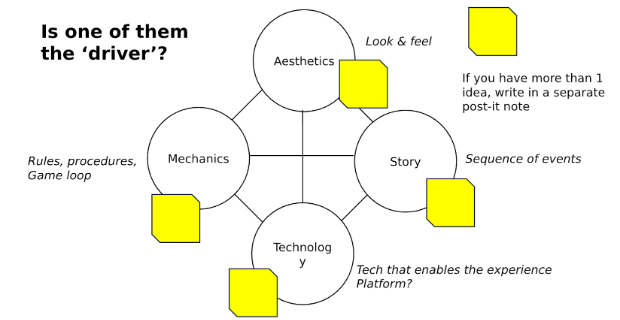Prep for this Week:
Watch Jacob Geller, ‘Bad Graphics’, https://www.youtube.com/watch?v=-yVs2E4aldg
Read Molly Bang (2016 – 2nd Edition) Picture This: How Pictures Work and Scott McCloud (1993) Understanding Comics
Play
1.Monument Valley, UsTwo
‘Capture the essence of experiences within the game, it will feed your design intention’
Examples of articulating your essential experience-
- To have the feeling of overcoming demons from an unbalanced environment
- To make the player feel truly vulnerable and alone in a large world by using a sense of scale and by implementing characters that the player will never interact with but will forever have a presence within the game.
Ask yourself- what is the experience of the game? What is essential (needed) for that experience to happen? How can my game capture that essence?
Dig into the why of your game. An example of digging deeper is turning ‘our game will feature 2D puzzles and platforming’ into ‘Our players will achieve a state of flow through challenging, precision gameplay’
Exercise 1:
I would like players to [experiential verb; Feel, Think, Experience] [something]
I would like players to experience a range of different emotions throughout the game
↪ I would like the players to experience concern through the actions of the character
What is concern? Is there a scale for this? Is my level of concern on an action different to what another player would feel?
What factors make people concerned? Does this link to any other feelings or is this the initial part of this feeling?
What makes people feel concerned?
When people are concerned they usually feel a sense of stress and uncertainty of how the situation will end.
Dr. Robert Plutchik’s Wheel of Emotions, using this to link my statement to an emotional bond.
Value + Arousal = Emotional States

Applying a psychology illustration captured into a game design experience.
Play Structures , Aesthetics , Elemental Tetrad
Play Structures:

(Ludus) to (Paidia) – my idea so far sits inbetween the two on the structured side
What are the emotional responses envoked in the player (from MDA)?
1. Sensation Game as sense-pleasure
2. Fantasy Game as make-believe
3. Narrative Game as drama
4. Challenge Game as obstacle course
5. Fellowship Game as social framework
6. Discovery Game as uncharted territory
7. Expression Game as self-discovery
8. Submission Game as pastime
What supports that experience?

Guest speaker
You had a session with JAKe;aspects mentioned:
•Start with simple shapes
•Characters come fromobservations of real-worldpeople; some people can looklike characters… maybe theseare people that you havesome sort of relationship(family?)
•Archetypes: protagonist / avillain?
•Thumbnails can be gooddeliverables; sketches too
•Elevator pitch – how to pitch aconcept of your character
•You should not explaineverything about thecharacter; you want to let theplayer find it out (mystery boxmechanic)